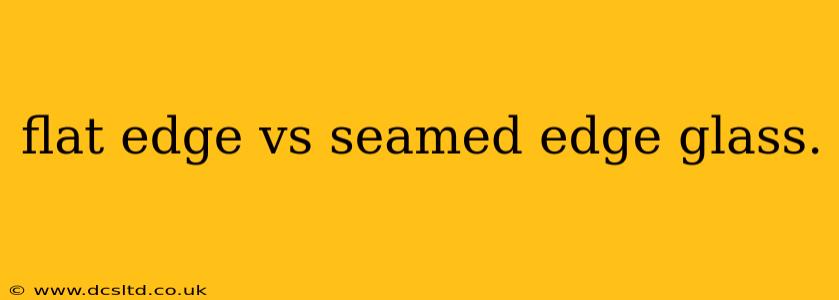Choosing the right type of glass for your project can significantly impact its aesthetic appeal and overall functionality. Two popular edge types are flat edge and seamed edge glass. While both offer unique characteristics, understanding their differences is crucial for making an informed decision. This comprehensive guide will delve into the nuances of flat edge versus seamed edge glass, helping you determine which option best suits your needs.
What is Flat Edge Glass?
Flat edge glass, also known as polished edge glass, boasts a smooth, polished edge that is precisely ground and finished. This process eliminates any roughness or chipping, creating a clean, refined look. The edges are perfectly straight and parallel, resulting in a sleek, contemporary aesthetic. This type of glass is highly versatile and commonly used in a variety of applications, from sleek shower enclosures to minimalist tabletops.
Advantages of Flat Edge Glass:
- Sleek and Modern Appearance: The polished, smooth edges contribute to a sophisticated and contemporary design.
- Versatility: Suitable for a wide range of applications, including shower doors, tabletops, shelves, and more.
- Easy to Clean: The smooth edges prevent dirt and debris from accumulating, making cleaning effortless.
- Durability: When properly installed and cared for, flat edge glass is highly durable and long-lasting.
What is Seamed Edge Glass?
Seamed edge glass, in contrast to flat edge glass, features a slightly rougher, unfinished edge. The edges aren't polished, resulting in a more rustic or industrial feel. This type of glass is often less expensive than its polished counterpart. While not as visually refined, the seamed edge can add a unique character to certain design schemes.
Advantages of Seamed Edge Glass:
- Cost-Effective: Generally, seamed edge glass is less expensive to produce than flat edge glass due to the lack of polishing.
- Rustic Appeal: The unfinished edges contribute to a more natural, less refined aesthetic, which can complement specific design styles.
- Suitable for Certain Applications: It's often a suitable choice for applications where a polished edge isn't necessary, such as certain shelving units or backsplashes.
Flat Edge vs. Seamed Edge Glass: Key Differences Summarized
| Feature | Flat Edge Glass | Seamed Edge Glass |
|---|---|---|
| Edge Finish | Polished, smooth, precisely ground | Rough, unfinished |
| Appearance | Sleek, modern, refined | Rustic, industrial, less refined |
| Cost | Generally more expensive | Generally less expensive |
| Durability | High, when properly installed and cared for | Can be durable, but may be more prone to chipping |
| Cleaning | Easy | Can be more challenging to clean |
| Applications | Versatile: shower doors, tabletops, shelves | Specific applications where a rustic look is desired |
What are the different types of glass edges? (People Also Ask)
While this article primarily focuses on flat and seamed edges, it's important to note that many other edge types exist, including beveled, mitered, and ogee edges. Each provides a unique aesthetic and is best suited for different applications. Choosing the right edge depends heavily on the desired look and the overall design scheme.
What is the best type of glass edge for a shower enclosure? (People Also Ask)
For shower enclosures, flat edge glass is often preferred due to its sleek appearance, ease of cleaning, and overall durability. The smooth, polished edges prevent water from clinging and make maintenance much simpler. However, seamed edges might be considered for a more rustic-style bathroom.
Which glass edge is more durable? (People Also Ask)
Both flat edge and seamed edge glass can be durable. However, flat edge glass, with its precisely ground and polished edges, is generally considered more resistant to chipping and damage. Seamed edges, being unfinished, might be more susceptible to damage if not handled carefully.
How much does seamed edge glass cost? (People Also Ask)
The cost of seamed edge glass varies based on factors like thickness, size, and type of glass. Generally, it's less expensive than flat edge glass because it requires less processing. For precise pricing, it's best to consult with a local glass supplier.
Conclusion: Choosing the Right Edge for Your Project
Ultimately, the choice between flat edge and seamed edge glass depends on your specific needs and design preferences. Consider the desired aesthetic, budget, and application when making your decision. Flat edge glass offers a sophisticated, versatile option suitable for various projects, while seamed edge glass provides a more rustic, cost-effective alternative for specific applications. Remember to consult with a professional glass supplier for expert advice and accurate pricing.
